South Carolina is the home of many sedentary and migratory moths and butterflies and their caterpillars.
Multiple species are found on trees as they eat large tree leaves. Other caterpillars are found on plants and even legumes across the state.
Green, brown, and black caterpillars are all common in South Carolina.
Table of Contents
Are South Carolina Caterpillars Poisonous?
There are no poisonous caterpillars in South Carolina.
Furry caterpillars in South Carolina tend to come with skin reactions when handled. But their long hairs or spines aren’t poisonous to humans.
Caterpillars in South Carolina rely on camouflage coloring and techniques such as releasing foul smells to keep predators away instead of relying on poisonous or venomous stings.
Caterpillars in South Carolina
Here are some of the most common caterpillars the state is home to.
1. Gulf Fritillary Caterpillar
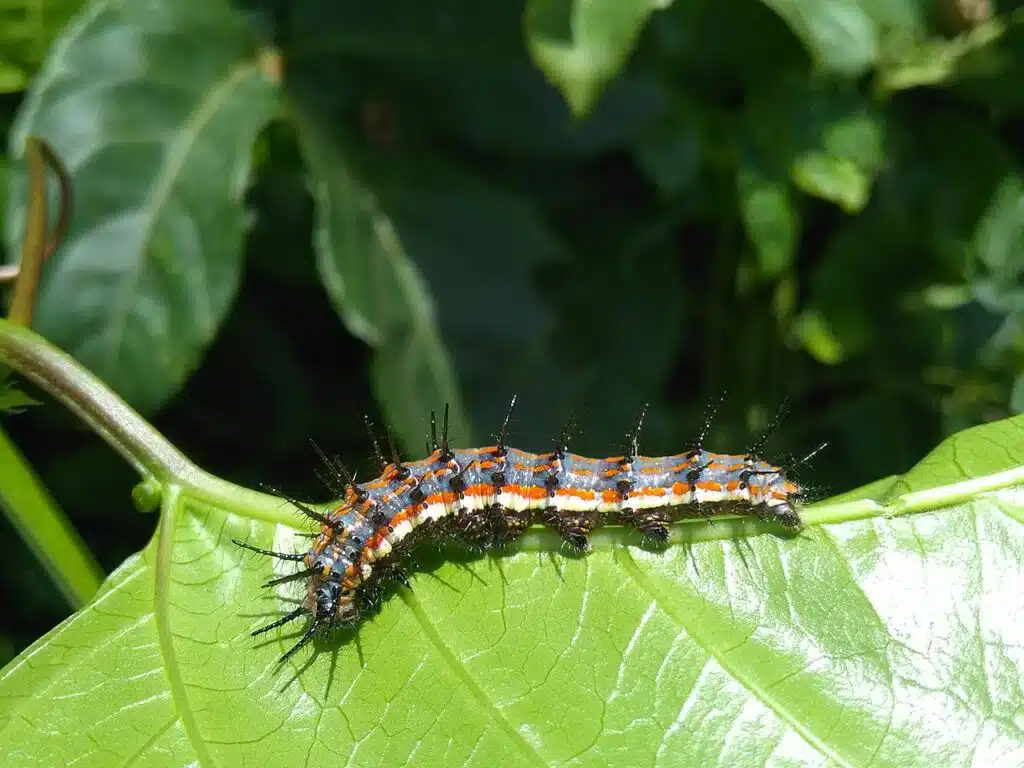
Gulf Fritillary (Dione vanillae) is some of the most common butterflies in South Carolina, especially in Southern parts of the state.
The butterflies have an orange-dominating color with black streaks on the wings.
Contrasting orange and black colors are also specific to the Gulf Fritillary Caterpillar.
Alternating black and orange (sometimes brown) colors are seen on the body of the species.
Black spikes also cover the body of the species so that it keeps potential predators away.
This is a species that first feed on soft leaves moving along to thicker leaves as it matures.
Sunny open habitats are an ideal location for both the butterflies and the caterpillars of the species.
2. Eastern Tiger Swallowtail Caterpillar
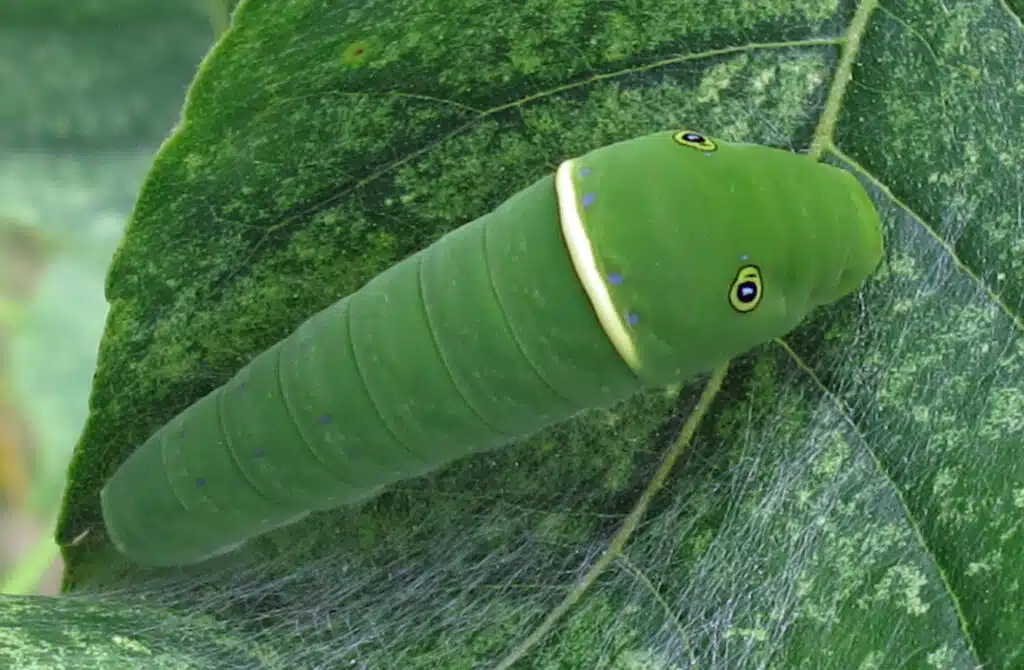
Eastern Tiger Swallowtail butterflies (Papilio glaucus) are some of the largest yellow butterflies in South Carolina.
There are 2 to 3 broods of its caterpillar in the state.
Yellow and black coloring seen on the Eastern Tiger Swallowtail Butterfly isn’t seen on the caterpillars of the species.
The caterpillars have a brown color with light brown spots on the sides. A white section across the central part of the body is seen in its later growth stages.
This white part is also known as a saddle in the world of caterpillars.
Eastern Tiger Swallowtail Caterpillars eventually turn green as they approach their later growth stages.
Various types of trees are ideal hosts for the species. Tulip trees are associated with Eastern Tiger Swallowtail Caterpillars even if the species also have tens of other hosts.
3. Monarch Caterpillar
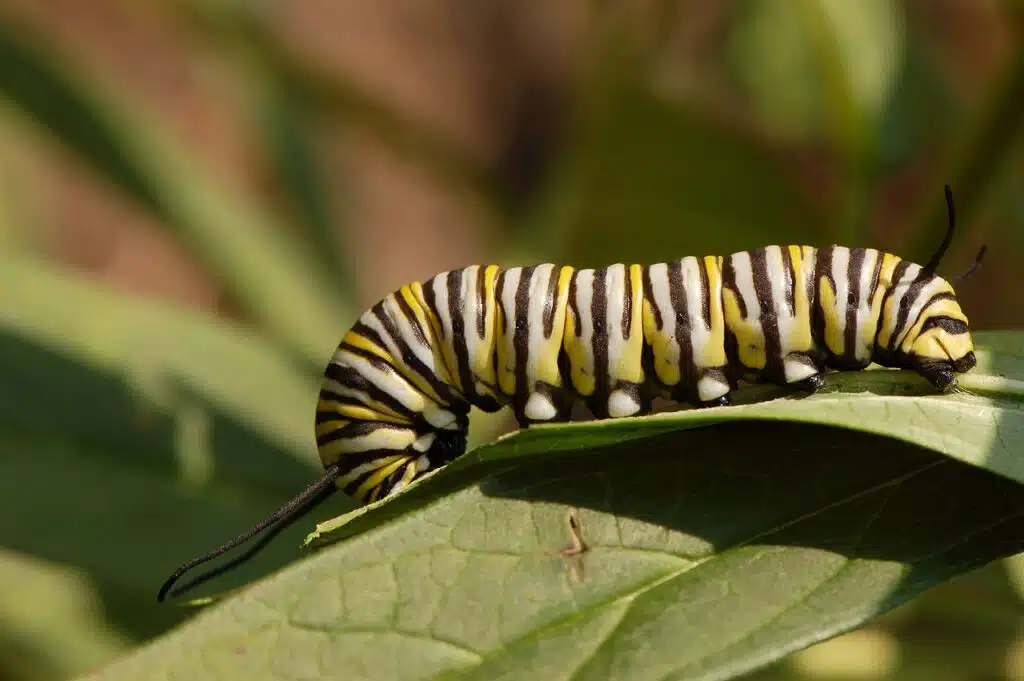
Monarch Butterflies (Danaus plexippus) are some of the most common migratory species moving from Northeastern habitats to Southern Carolina.
This species migrates before winter.
A common but not very efficient pollinator, the butterfly lays eggs which later turn into caterpillars.
White, black, and yellow colors and a banded body appearance are specific to the Monarch Caterpillar.
This species feeds on different types of milkweed. It can turn aggressive with low milkweed availability.,
Monarch Caterpillars are some of the most aggressive towards other caterpillars of the species whenever milkweed resources are low.
Due to the migratory status of the species, Monarch Caterpillars may occasionally be found on other types of hosts such as pine trees, with lower survival rates.
4. Common Buckeye Caterpillar
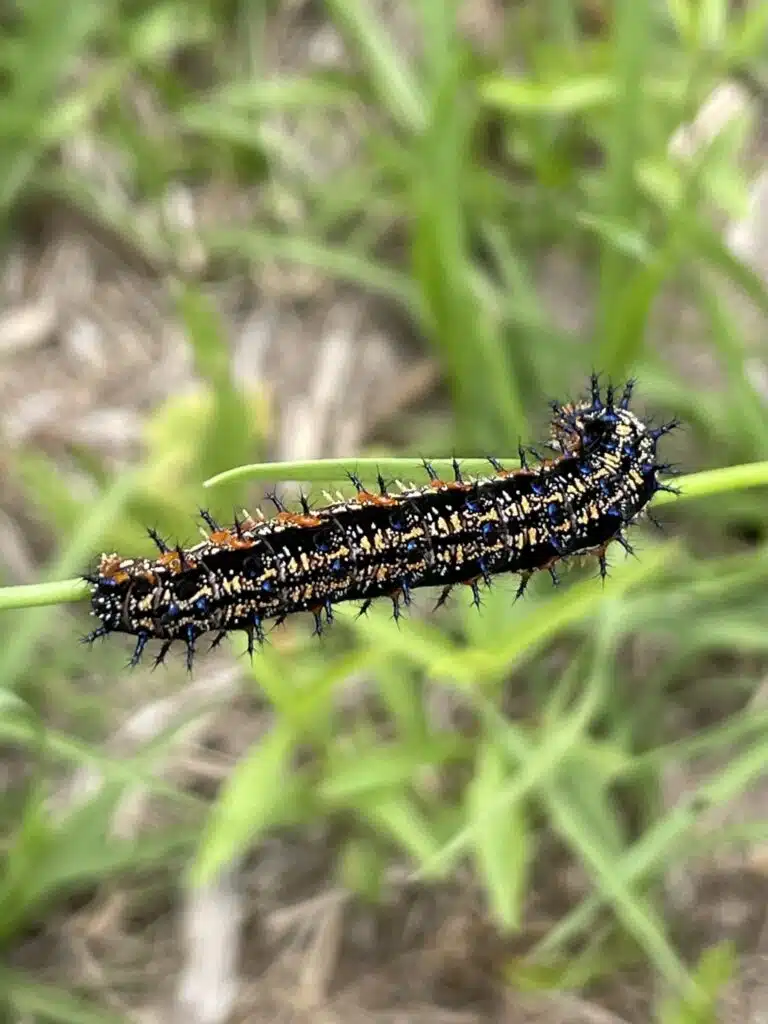
The Common Buckeye Caterpillar (Junonia coenia) is one of the longest-surviving butterfly species in the world.
It’s believed the species originates in Africa reaching North America through an Asian migration process.
Caterpillars of the species are known to be highly selective of their host plants.
Only plants rich in iridoid glycosides compounds are preferred by the species. This is a compound that makes them distasteful to predators.
Many species that eat caterpillars only eat the species low in iridoid glycosides which means Common Buckeye Caterpillars are among the species with a reduced risk of predation.
This black and brown caterpillar also has long black spines which further makes it looks dangerous or unappealing to predators.
5. Long-tailed Skipper Caterpillar
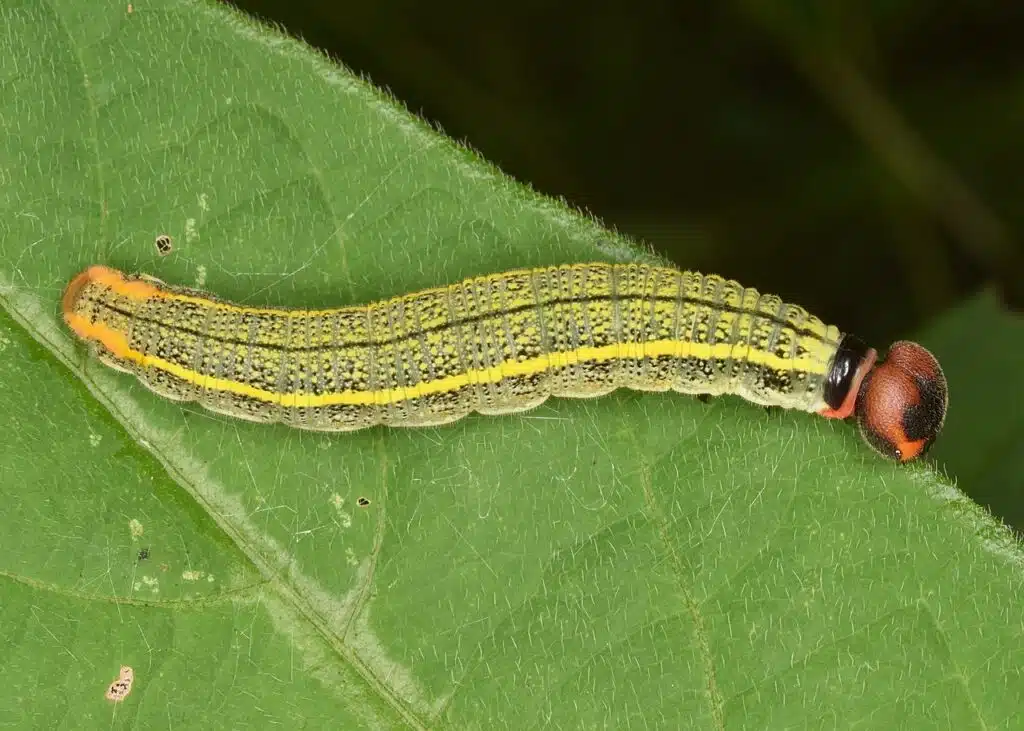
Long-tailed Skipper Caterpillars (Urbanus proteus) are the most common pest caterpillar in Southern Carolina.
This species feeds on beans and invades bean crops if left unmanaged.
Some people may refer to the species as the Bean Leafroller as the leaves curl up when impacted by the species.
Thriving in warm habitats, this is a species that cannot survive cold weather.
In South Carolina, it tends to be a major pest in the summer and a minor pest in the spring.
This is a caterpillar that also blends in with its surroundings as it features a base green color with a dark brown or a black contrasting head.
Its pupal stage is marked by dark brown uniform coloring.
6. North American Luna Moth Caterpillar
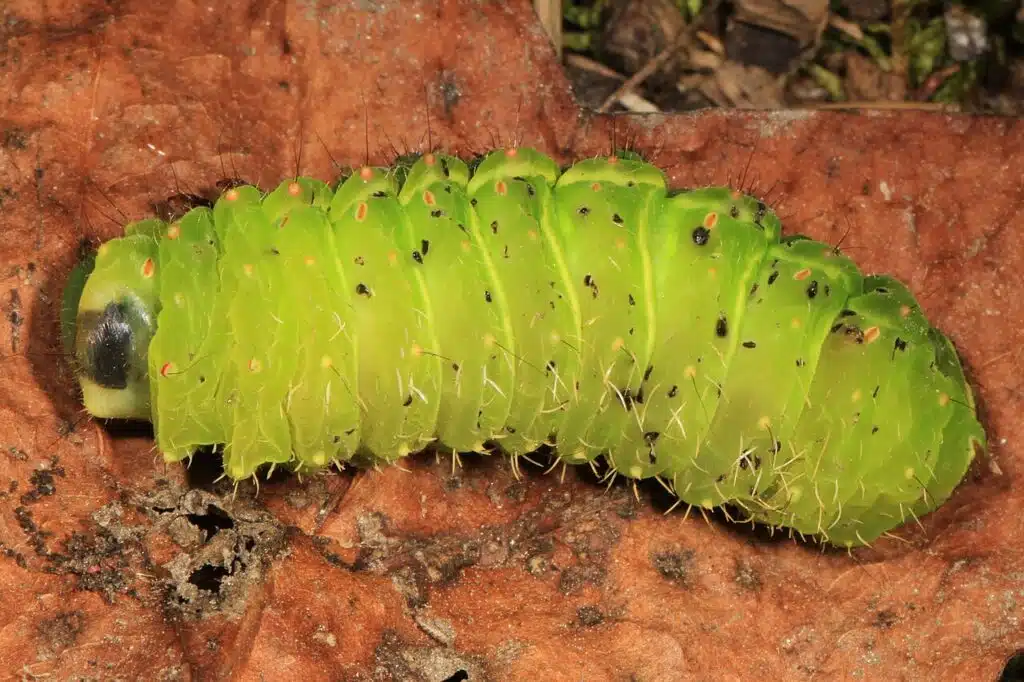
Some of the atypical caterpillars in the state are North American Luna Moth Caterpillars (Actias luna).
These are among the few species with defensive systems such as emitting clicking sounds.
Caterpillars of this family
make these sounds that scare predators, especially birds.
Another atypical form of defense that seems a mystery for the species is its capacity to vomit on demand.
It does this to repel potential predators.
The green color is specific to the species. Its color changes as the species go from one growth stage to another.
A red dorsal nuance is distinguished on the dorsal side of the caterpillar as it approaches its maximum growth period.
7. Red-spotted Admiral Caterpillar
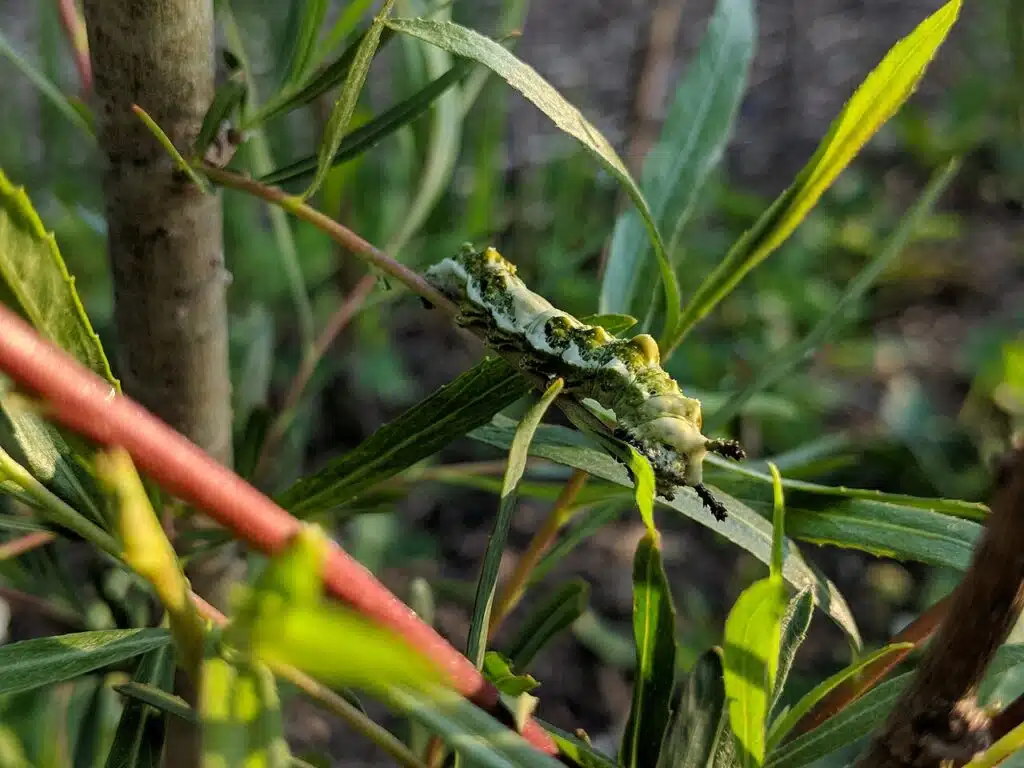
Much of the life of the Red-spotted Admiral Caterpillar (Limenitis arthemis) is spent mimicking Pinevine Swallowtail Butterflies.
Red-spotted Admiral Caterpillars live in woodlands. They feed on broad leaf plants while adults eat tree sap and even dung.
This is a species also marked by mimicry as a caterpillar.
Mimicking bird droppings is the main physical trait of the Red-Spotted Admiral Caterpillar.
This is a species that feeds on Black Cherry and willow. It has white to pink colors on its green body which makes it look distasteful to potential predators.
Once the adult butterfly emerges, the species loses its green base color turning into a blue and black butterfly.
The species is common in South Carolina, albeit not as common as in Florida.
8. Forest Tent Caterpillar
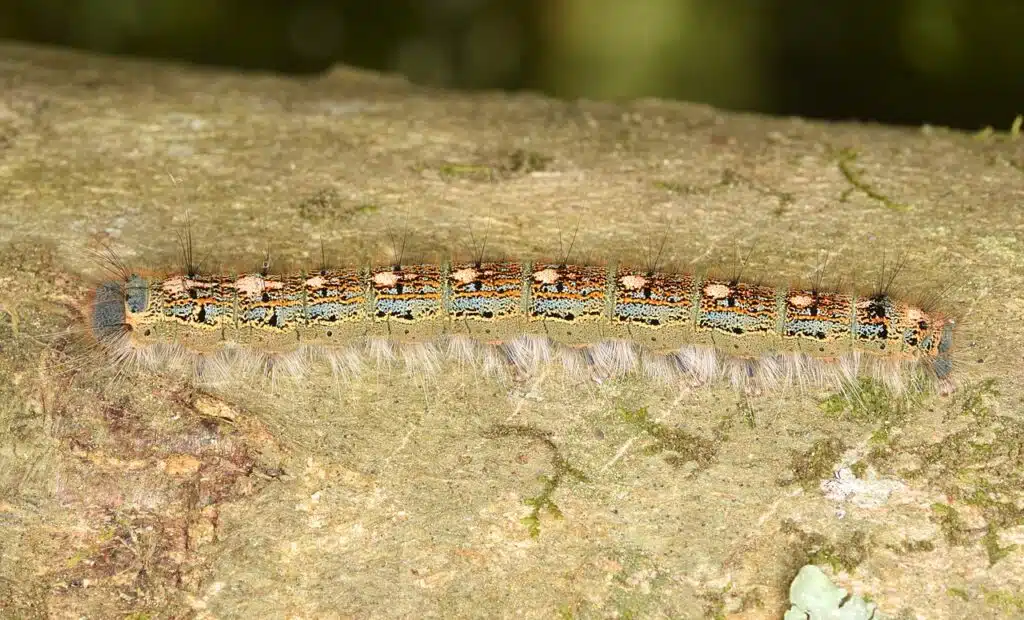
There’s always a risk for Forest Tent Caterpillars (Malacosoma disstria) to spread in an outbreak.
Once per decade, this type of caterpillar can defoliate trees and plants in its path, including host trees in South Carolina.
Forest Tent Caterpillars feed on species such as oak and aspen.
Females lay clusters of hundreds of eggs that hatch in the spring. While most years the species has no major impact on these trees, outbreaks are recorded and can kill host trees.
This caterpillar species is identified by its unique colors or color combinations.
Black and blue colors are seen across its body.
This type of caterpillar has a black body with multiple blue stripes and white dorsal dots that contrast its dark appearance.
White and yellow hairs are also seen on their lower sides.
9. Cloudless Sulphur Caterpillar
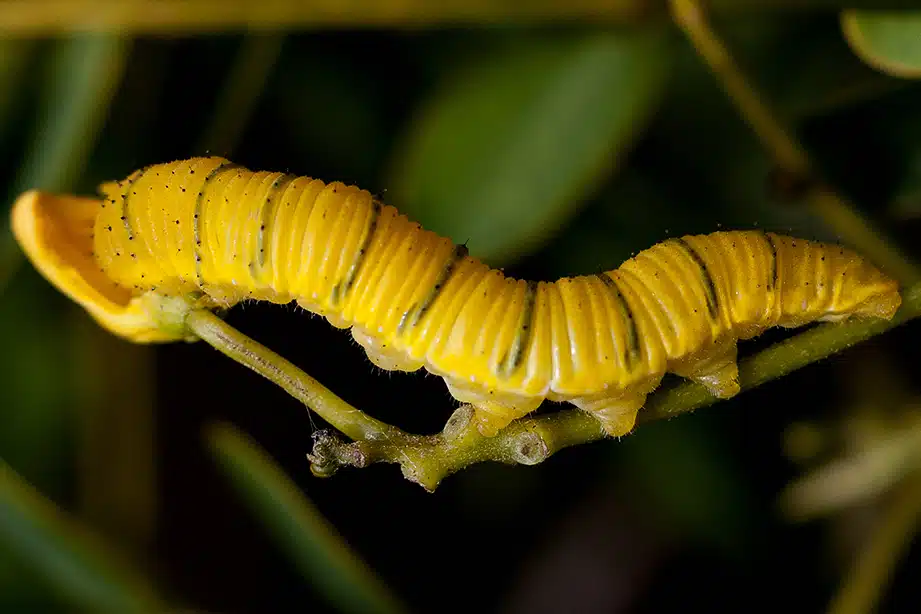
Some of the most common butterflies of the Southeast are Cloudless Sulphur Butterflies (Phoebis sennae). The species is highly common in South Carolina and even more common in other states such as Florida.
A yellow butterfly, this species bears some resemblance to its caterpillar in terms of coloring.
A pale green species at first, the caterpillar only has yellow lateral bands.
It later becomes a yellow caterpillar with black secondary colors in the form of crossbands.
Sensitive peas and partridge peas are some of the most common hosts of the species.
This species is always present in the spring as a caterpillar in the same areas where mating took place in the previous fall.
Overwintering eggs are laid on pea family plants. They have a dark yellow elongated appearance.
10. Polyphemus Moth Caterpillar
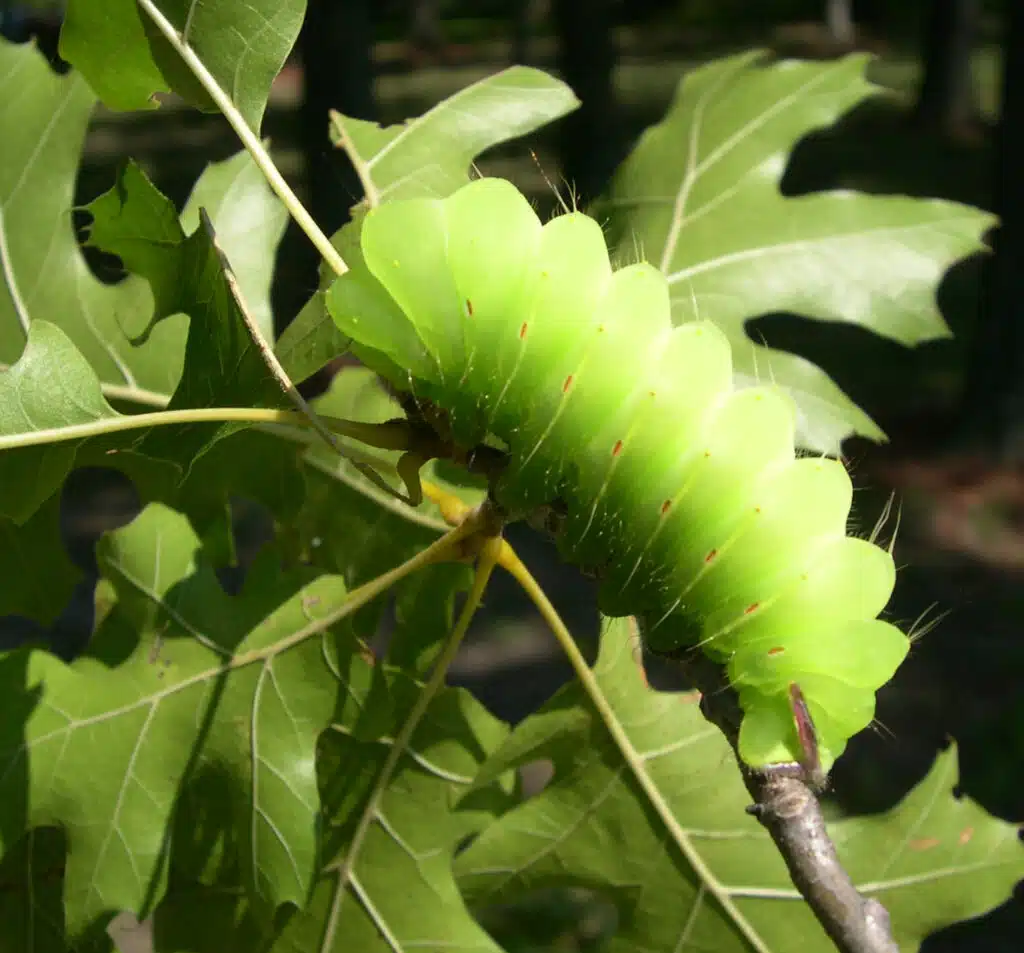
Polyphemus Moths (Antheraea polyphemus) are some of the most common moth species in the state.
Their common nature is best seen when these moths make it indoors as the species are attracted to lights at night.
If the adult is mostly gray and white, the caterpillars of the species have green coloring.
They begin life as white and black caterpillars with just a few contrasting yellow spots on the body.
Polyphemus Moth Caterpillars eventually grow into green caterpillars.
The color and the positioning of the species might not make it similar to other caterpillars.
It sometimes adopts the sphinx position with an elevated head so that it doesn’t look like a caterpillar at all.
11. Pearl Crescent Caterpillar
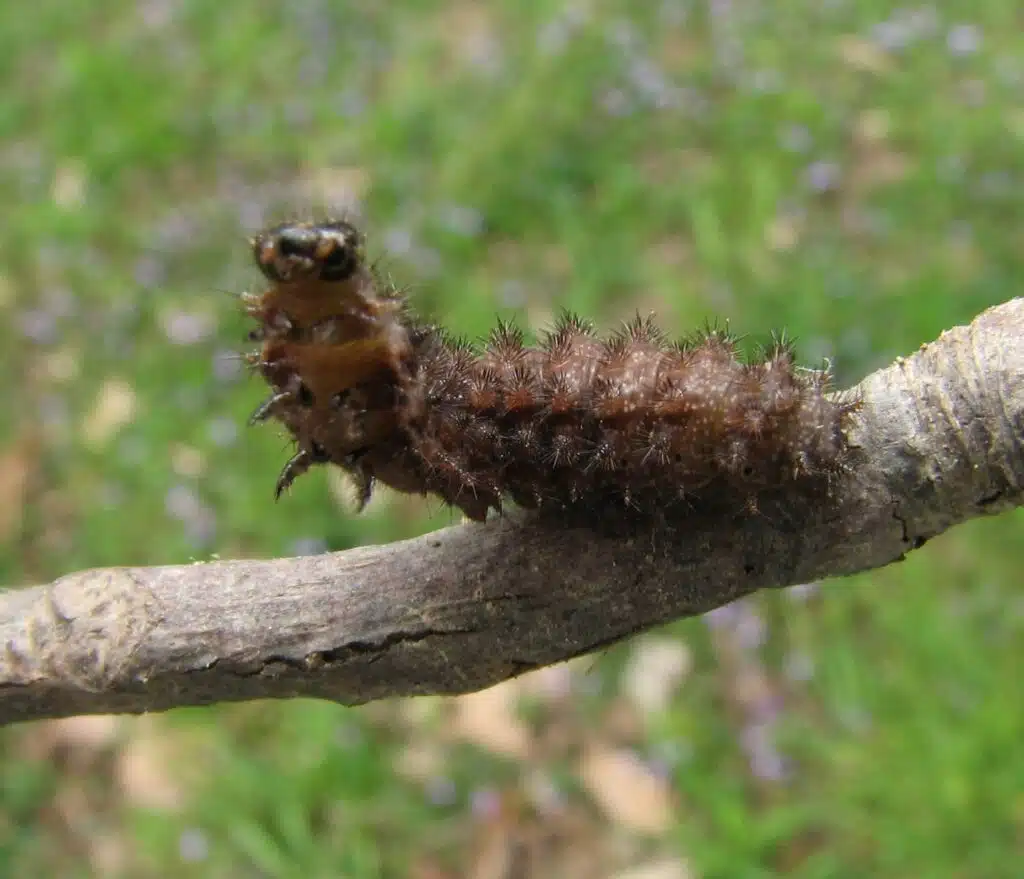
Orange coloring with black margins is specific to the Pearl Crescent Butterfly (Phyciodes tharos).
Some of the colors adult butterflies exhibit are also spotted on the caterpillars of the species.
These types of caterpillars have black and orange or black and brown bodies covered in short black spines.
The species is among the reduced number of butterflies that only lays eggs in small numbers, preferably on the underside of leaves.
A reduced number of emerging caterpillars are spotted as a result.
Pearl Crescent Caterpillars feed on different types of asters. Adults don’t like asters as they prefer dogbane and other sources of nectar.
This species can be spotted as soon as April and it may come in a few broods up until late fall.
12. Palamedes Swallowtail Caterpillar
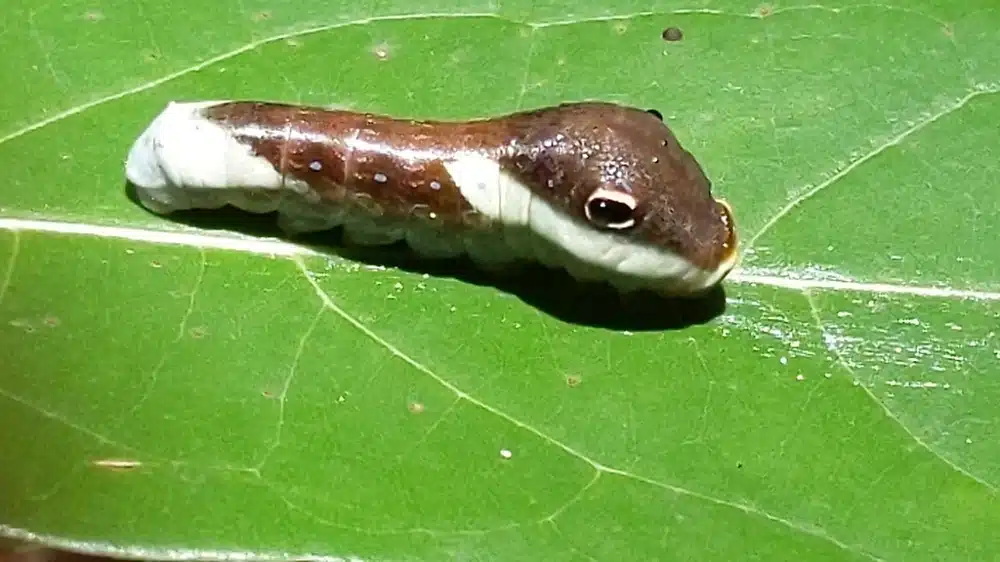
The Southeast is the home to the Palamedes Swallowtail Caterpillar (Papilio palamedes).
A dark brown to black color with rows of yellow spots are specific to the large butterfly.
Contrasting colors are also specific to the caterpillar of this common butterfly species.
A dark yellow-brown color is seen on the first instar caterpillar.
Its color darkens to a dark brown color with a white saddle and white colors which makes the species resemble bird droppings.
The final growth stages of the caterpillar are marked by dual coloring. Green is the dorsal color of the caterpillar while brown is seen on its sides and its ventral side.
The caterpillar turns yellow dorsally and orange ventrally just before pupation.
Large eyespots are seen on the head of the species throughout its growth stages.
13. American Lady Caterpillar
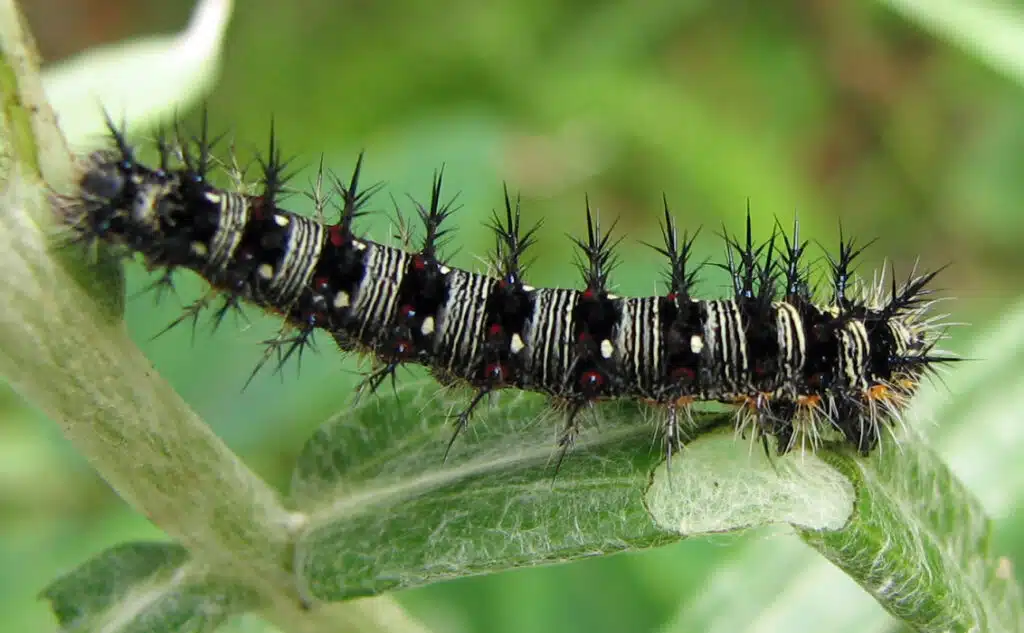
Some of the smallest caterpillars in South Carolina are American Lady Caterpillars (Vanessa virginiensis).
These types of caterpillars have a maximum size of 1.6 inches, many of them being even shorter.
This is also one of the dark caterpillar species of South Carolina as black dominates dorsal and ventral coloring.
White bands and white dots are seen across the body of this species.
Sandhills and woodlands are some of the most common habitats of the species.
You can find these types of caterpillars wrapping the leaves of host plants in spider-like silk webs.
These webs protect the caterpillars in their early growth stages.
14. Silver-spotted Skipper Caterpillar
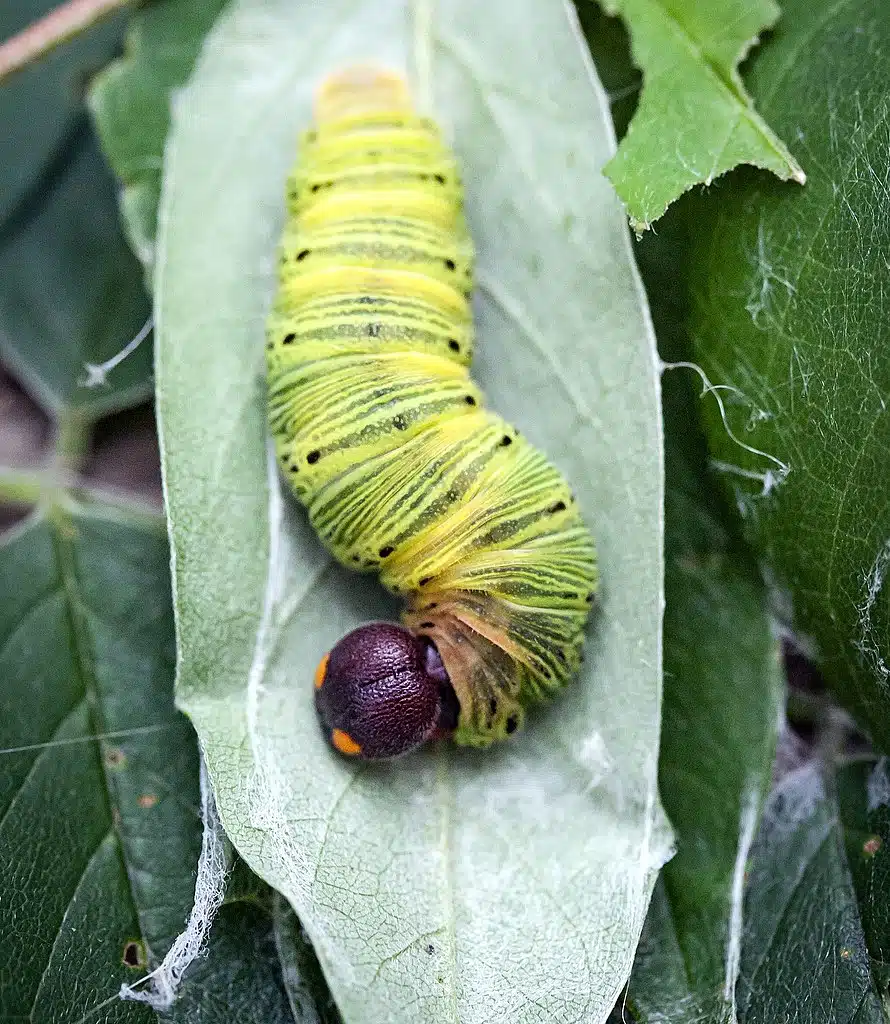
Vines and shrubs are some of the most common hosts of the Silver-spotted Skipper Caterpillar (Epargyreus clarus).
Brown colors are specific to skipper butterflies that fold their forewings up.
The caterpillar of this skipper species only has a brown head while its body has a bright yellow color.
Silver-spotted Skipper Caterpillars are also some of the largest types of caterpillars in the state.
They regularly grow to a size of just over 2 inches and also have a robust bodies.
Apart from the vivid yellow color which makes this species appear poisonous to some predators, this caterpillar also has other defensive techniques.
For example, it can regurgitate its food in front of predators to appear distasteful.
15. Imperial Moth Caterpillar
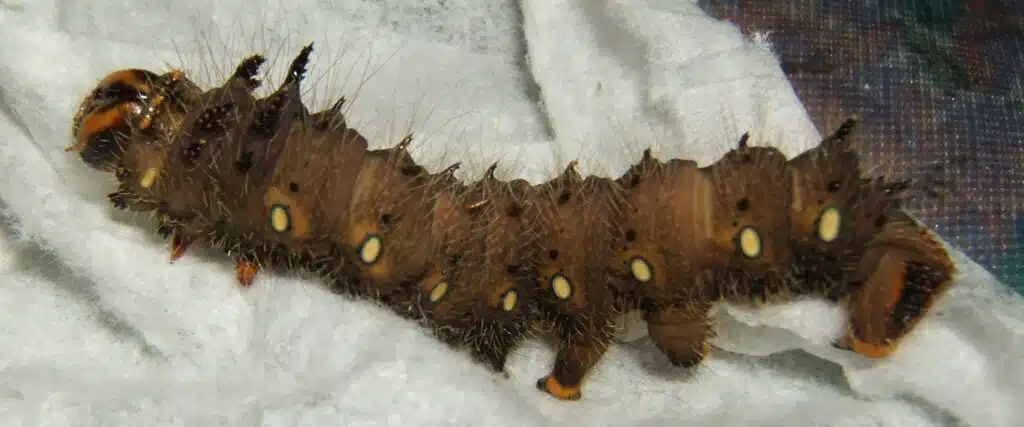
Some of the oldest types of North American trees are the hosts of the Imperial Moth Caterpillar (Eacles imperialis).
This is a species that feeds on the leaves of oak trees but it can also survive at high altitudes feeding on pine trees.
Imperial Moth Caterpillars have a brighter color in the first days of their life, slowly turning dark brown or even black just before pupating.
This species is also covered in black spines and its body may seem unpalatable to different types of predators.
You can find this species is active from spring to late summer but weather and even its host impact its season.
While hardwood trees and pines are preferred types of hosts, Imperial Moth Caterpillars are also spotted on different types of hosts such as sweet gym and eucalyptus.
16. Ailanthus Webworm
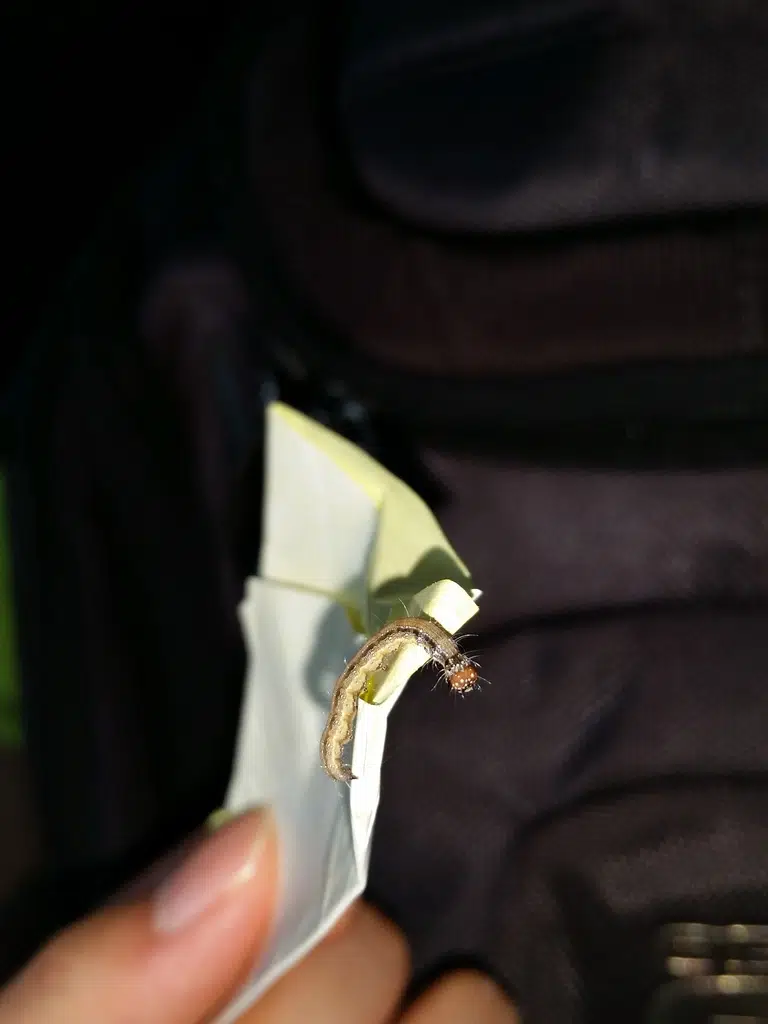
This species of caterpillar (Atteva aurea) is closely tied to The Tree of Heaven, a rare species which has extended its range along the Eastern and Southeastern Coast.
The tree has adapted to living in cooler climates, not just in Peninsular Florida.
It shortly made its way North, reaching South Carolina in its expansion.
Apart from being very specific about its host tree, this is also a species with a dark appearance.
Black and brown nuances are important for this species.
Light brown and dark brown patterns are distinguished on its dorsal side with black being spotted on the head and around the anal plate.
This species also grows a few scarce white hairs are it matures.
17. Black Swallowtail Caterpillar
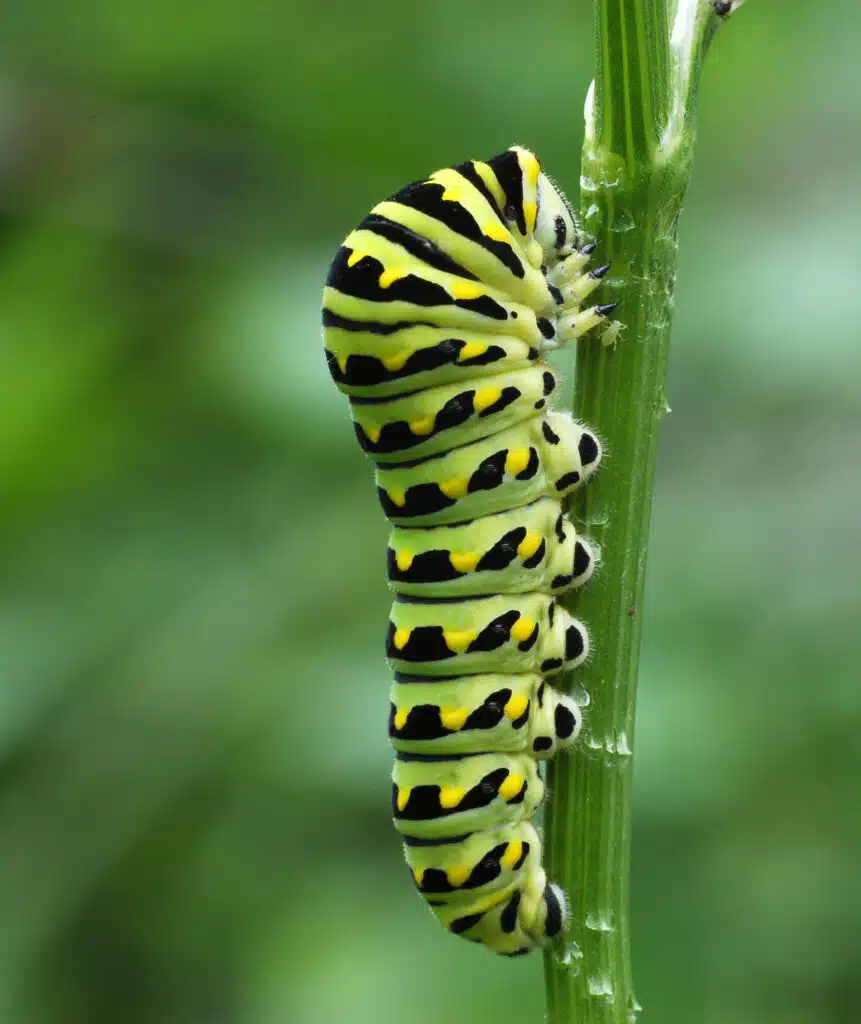
The Black Swallowtail Butterfly (Papilio polyxenes) is one of the most common large butterflies in the state.
Caterpillars of the species are seen after the female butterfly mates with multiple males in an act of polyandry.
The emerged caterpillar bears little resemblance to the coloring of the adult butterfly in its last growth stages, but it resembles adults in its first instar with its all-black color.
A green body with black crossbands is specific to this species as it matures.
Yellow spots are distinguished along its crossbands as well.
It can take up to 30 days for this caterpillar to grow and be ready for pupation.
Exceptions apply as some Black Swallowtail Caterpillars have been found to pupate within 10-15 days.
18. Giant Woolly Bear
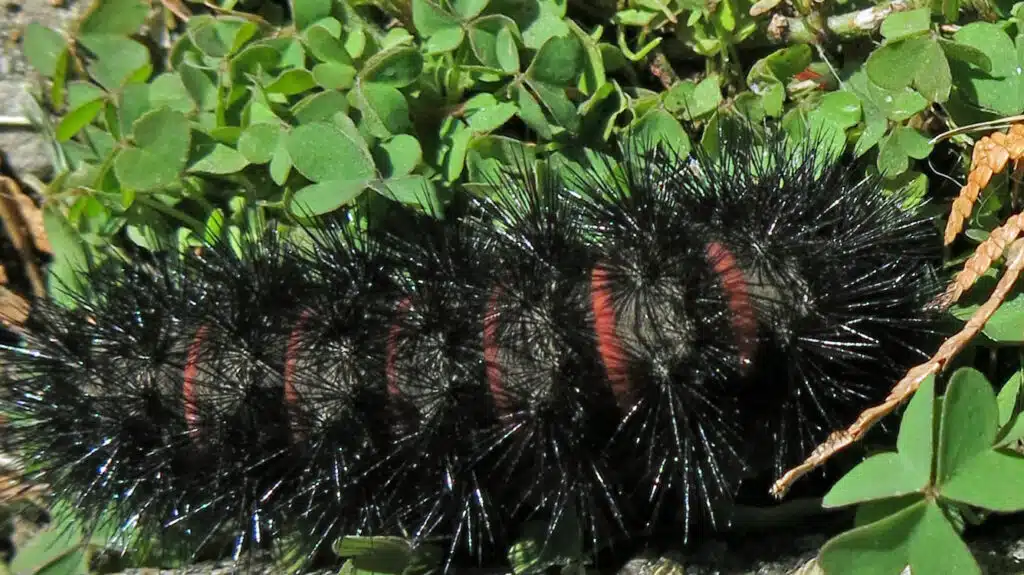
One of the species with a potential pest status in the state is the Giant Woolly Bear (Hypercompe scribonia). This is a species that can also cause skin urticaria to those that handle it.
Caterpillars of this group are known for their brown and black appearance in the first growth stages.
As the species matures, it starts to grow dense long black hairs on its body.
This is a woolly species entirely covered in hairs by its last instar.
Many plants are noted as their possible hosts. Its damages are most feared when it comes to legumes and fruits.
This is a caterpillar spotted on bananas, avocados, and oranges, alongside violets and dandelions.
19. Fall Webworm
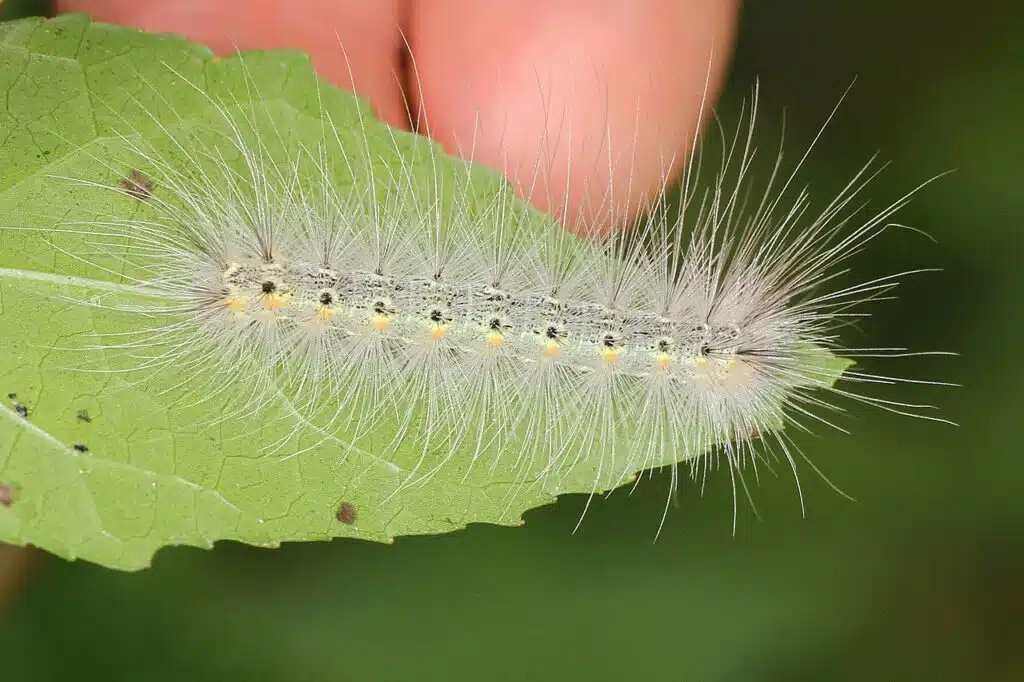
Fall Webworms (Hyphantria cunea) represent a white moth species known to have a potential pest status in woodlands.
Statistics show that impacted host trees are mostly trees that aren’t healthy, but there’s always a risk with this species.
Both the Fall Webworm Moth and the caterpillar of the species are marked by bright almost pure-white coloring.
The caterpillar of the species reaches a point where its white body is covered in long white hairs in its late growth stages.
Fall Webworm Caterpillars can defoliate trees in woodlands on occasion.
Elm tends to be a commonly impacted species. Cottonwood is also impacted.
A growing number of reports show this species as a potential pest of fruit trees as well.
20. White-marked Tussock Moth Caterpillar
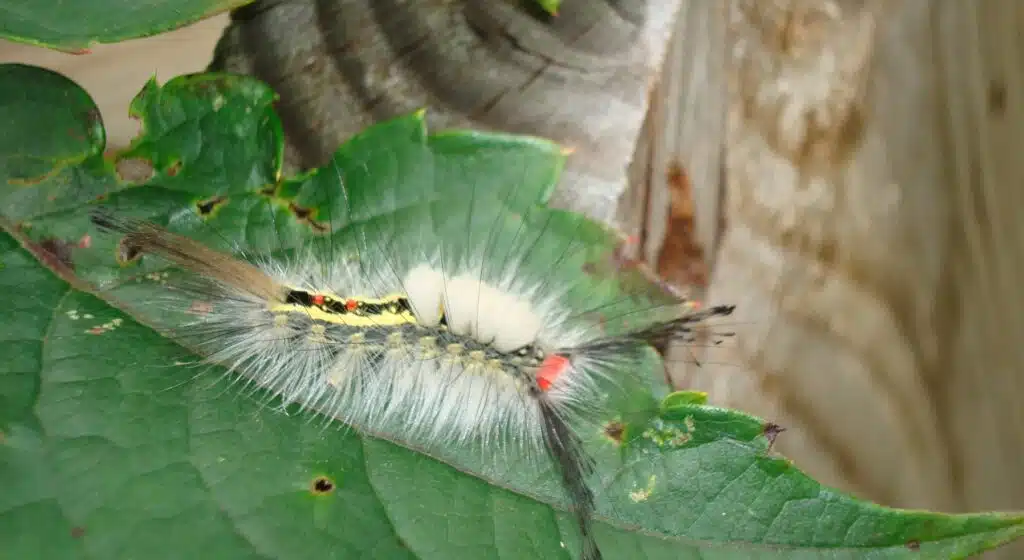
July and August mark the months when this White-marked Tussock Moth (Orgyia leucostigma) is highly active.
This is a species with an atypical caterpillar due to the presence of large defensive glands on its dorsal side.
These glands look like small white or cream balls and aim to keep predators away by giving off the impression of a poisonous species.
Sometimes spotted in a red base color with black stripes, long hairs, and tufts, this species is specific to different trees commonly found in South Carolina.
Hickory, oak, and larch are some of the hosts this species is seen on.
Most of these trees aren’t highly affected by the caterpillar as they progress to solitary living and eventually turn to moths.
21. Sleepy Orange Caterpillar
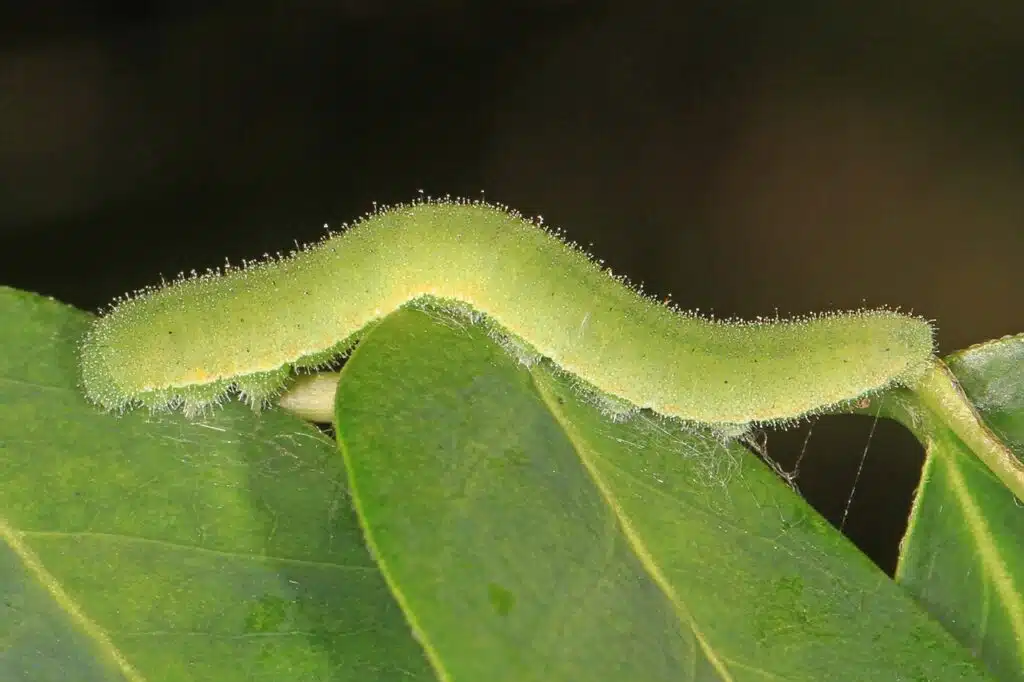
A bright species, the Sleepy Orange Caterpillar (Abaeis nicippe) bears resemble the adult colorful butterfly.
Green and yellow growth stages are specific to this caterpillar which resembles the yellow-orange butterfly.
Open fields and roadsides are the habitats of the host plants Sleepy Orange Caterpillars prefer.
This is a species that likes pea plants as well as wild sennas.
It uses these plants as hosts in its caterpillar stage but adult butterflies move on to other foods.
The butterflies of the species are even spotted puddling, a habit that allows them to extract nutrients directly from mud.
Many Sleepy Orange Caterpillars in South Carolina emerge after females migrate from Northern territories.
22. Banded Tussock Moth Caterpillar
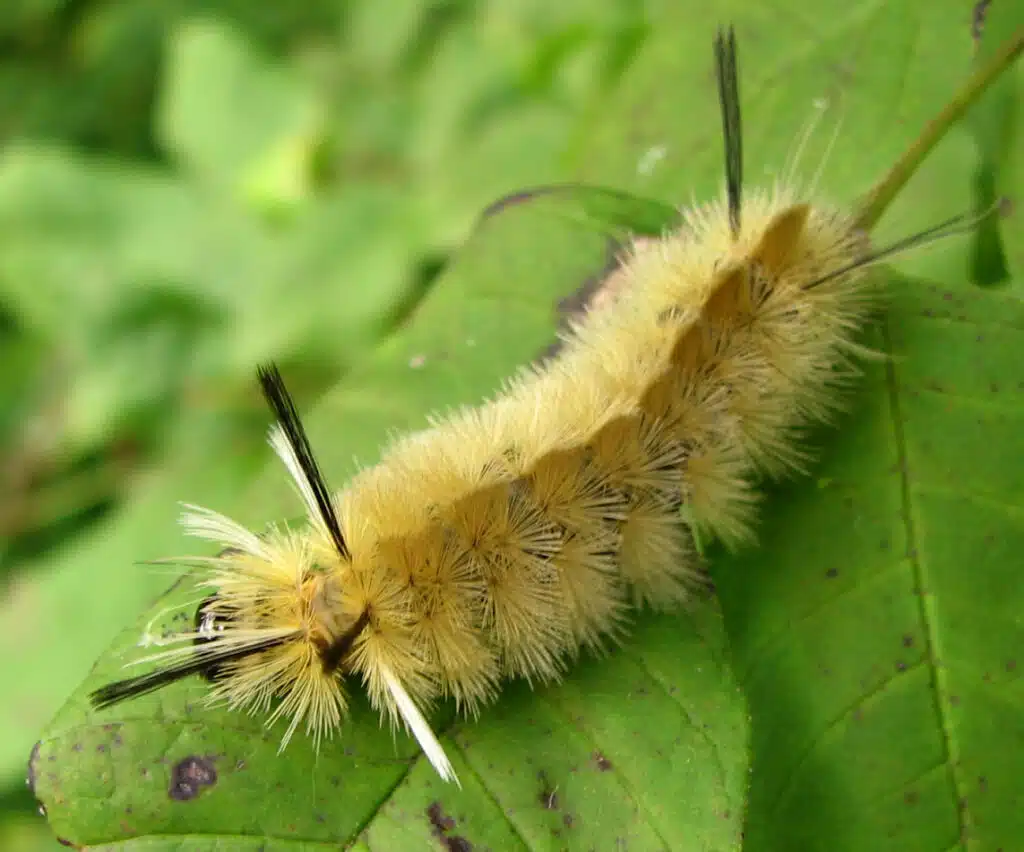
A hairy body and possible skin reactions are some of the first characteristics associated with the Banded Tussock Moth Caterpillar (Halysidota tessellaris).
This species has a dark body which eventually is covered in gray or yellow hairs. Black tufts are also visible across its body.
Some studies even show these types of caterpillars absorb toxins so that they are safe from predators.
Banded Tussock Moth Caterpillar appears in 2 broods per year with the most notable damages to its hosts being specific to the end of the summer.
This is a species known to impact many types of trees.
Ash and birch are among its favorite hosts.
Damages to these trees tend to be minimal as these caterpillars are mostly present towards the end of the summer on their hosts.
23. Gray Hairstreak Caterpillar
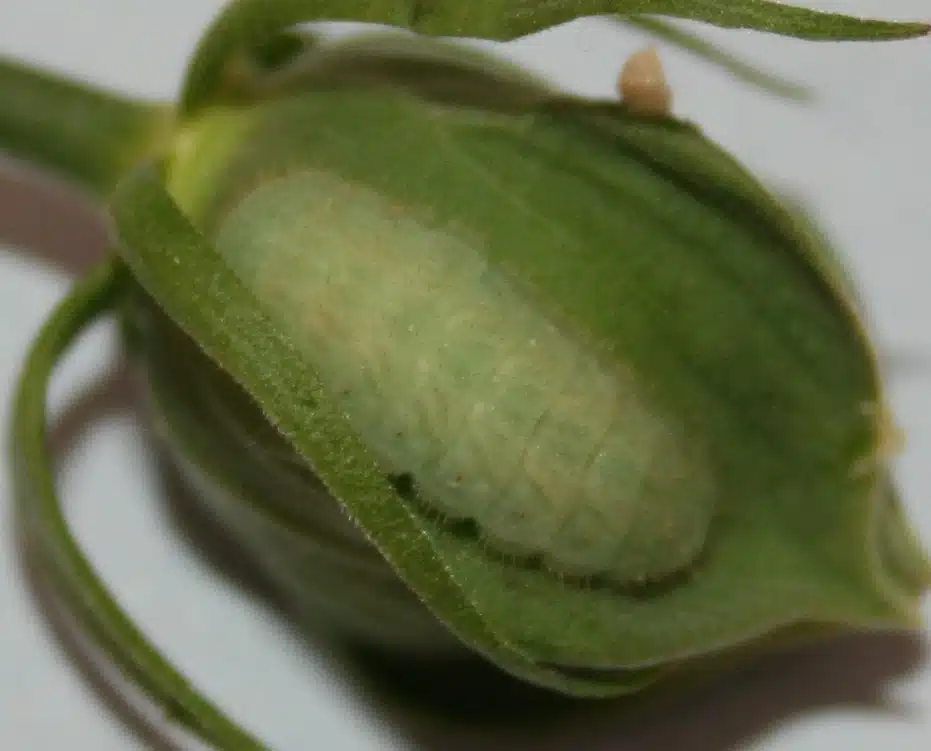
Pea and mallow are some of the ideal hosts of the Gray Hairstreak Caterpillar (Strymon melinus).
This is a species with very bright coloring. White and pink coloring is an event tied to this caterpillar.
Unlike the adult which is mostly gray and black, the caterpillars are bright and interested in different types of plants.
Gray Hairstreak butterflies are fans of dogbane.
Even if they prefer different types of hosts, Gray Hairstreak Caterpillars share the same dry open fields and meadows with adults.
You can spot Gray Hairstreak Butterflies on trees and know caterpillars are close as well.
Unlike other species of caterpillars, the young Gray Hairstreak caterpillar also eats different parts of its hosts such as flowers.
24. Variegated Fritillary Caterpillar
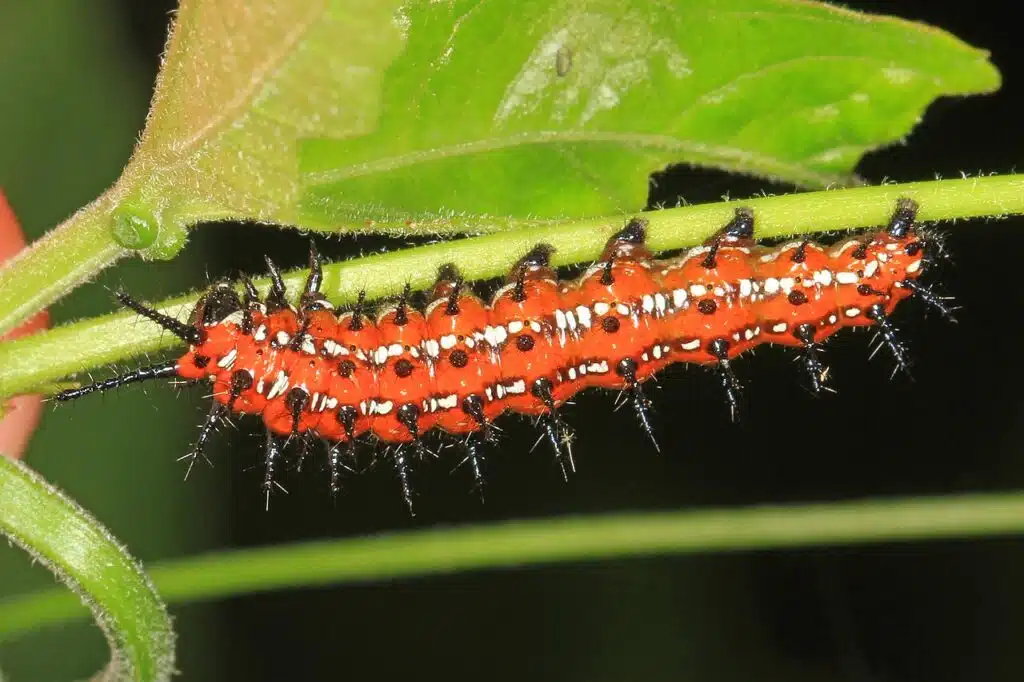
Variegated Fritillary Butterflies (Euptoieta claudia) are some of the most divisive butterflies in terms of habitat.
They can be migratory or sedentary. Even more, they can only be migratory once every few years.
This is a species that lays eggs on different plants such as white flower pansies across the state.
It’s these flowers that many butterflies from other regions come for in South Carolina.
The emerged caterpillar has a dark appearance with a combination of brown and black coloring.
Varying numbers of this caterpillar can be seen each year.
Unlike in other states, South Carolina tends to be home to multiple broods per year.
25. Eastern Tent Caterpillar
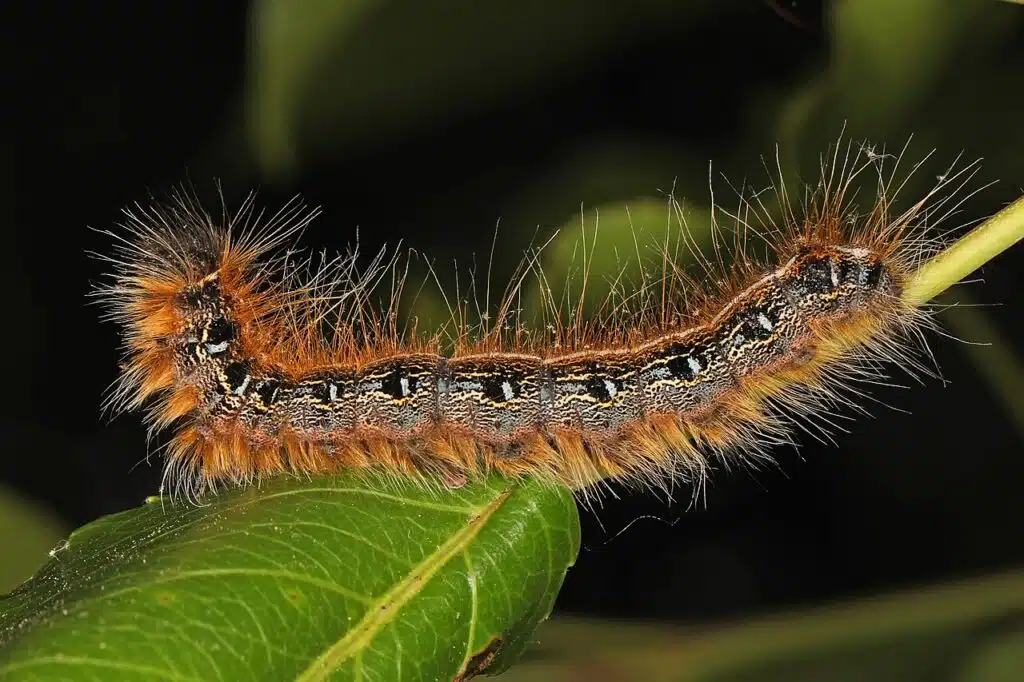
Wild cherry and other trees are the hosts of Eastern Tent Caterpillars (Malacosoma americana).
This is one of the most social species across South Carolina.
Eastern Tent Caterpillars represent one of the first species to appear in the spring.
These caterpillars are spotted sooner than others as they feed in direct sunlight. They rely on warmth for digestion.
Clusters of caterpillars are seen the building and expanding a tent-like silk cocoon on trees.
This is a species with a dark appearance and one of the few caterpillars in South Carolina with blue coloring.
26. Spicebush Swallowtail Caterpillar
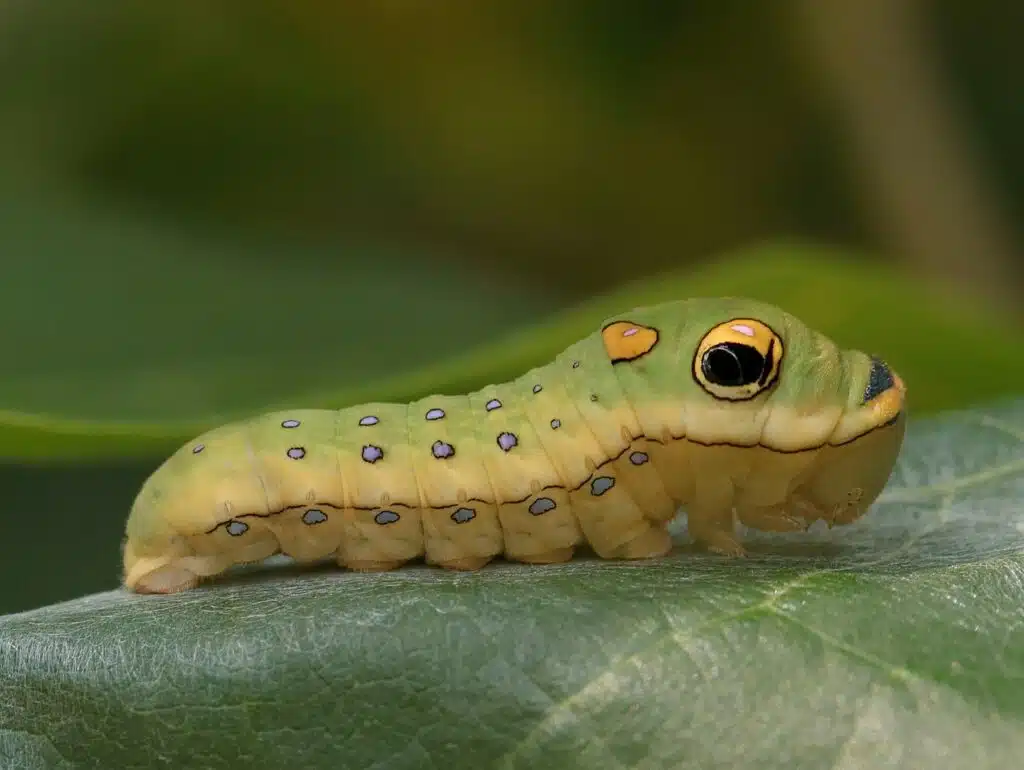
As the name of this species suggests, these caterpillars (Papilio troilus) are mostly tied to spicebush hosts.
Butterflies of this genus are known to feed on dogbane and similar plants. They are popular due to their black wings.
The caterpillar has distinct traits as well.
For example, the early-stage caterpillar hides in a rolled leaf for protection.
This is also a caterpillar that has a bad smell aimed to keep predators and other animals away.
A green or a yellow-green color is later specific to this species.
Large eyespots complete its list of defensive mechanisms.
This caterpillar may also overwinter in the larval stage. This is the time it takes on the colors of its ecosystem, which may be either green or brown.
27. Fir Tussock Moth Caterpillar
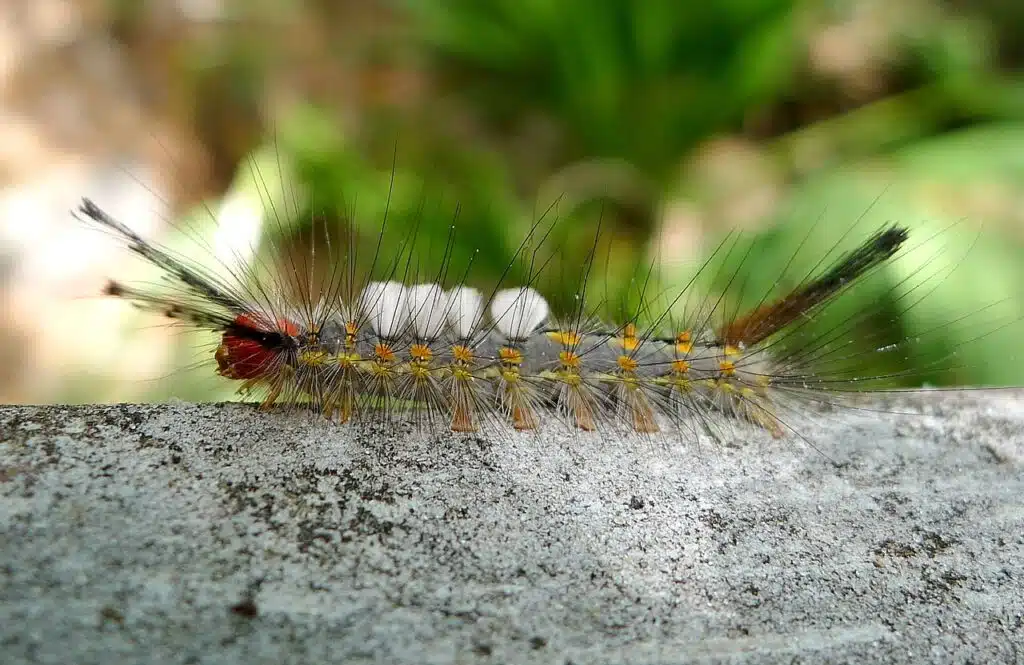
Another species known to cause mild skin rashes or urticaria is the Fir Tussock Moth Caterpillar (Orgyia detrita).
This is a species characterized by contrasting colors. It has white tufts and black tufts across its body.
The Fir Tussock Moth Caterpillar is further known for having red coloring on its head.
Orange or yellow-orange spots may also be seen along the sides of its body.
White tufts of hair in the form of glands further contrast the dorsal coloring of the species.
28. Question Mark Caterpillar
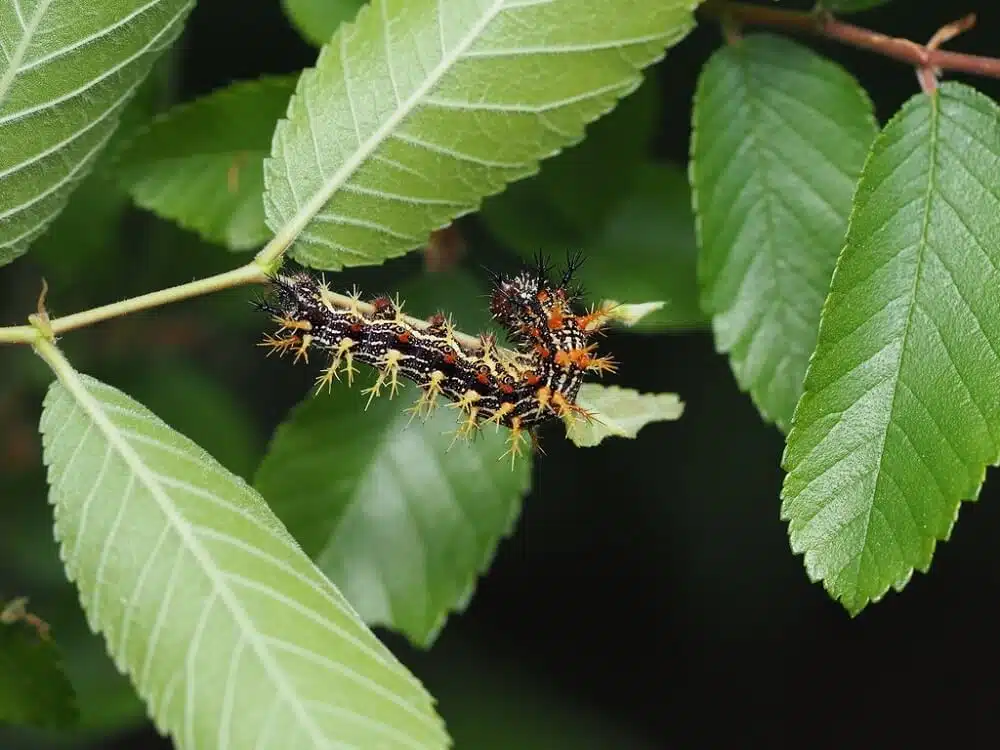
Question Mark Butterflies (Polygonia interrogationis) are among the most common species resembling leaves across the state.
This is a species characterized by brown, gray, and even red colors which mimic the appearance of a dead leaf.
This type of camouflage color is also specific to the caterpillar of the species.
It goes through multiple color changes but a black-and-yellow color combination and a body covered in short spines are common for the species.
Its capacity to adapt its colors to the colors of its environment means the Question Mark Caterpillar is less distinguishable on a host such as American elms compared to other species.
29. Tersa Sphinx Caterpillar
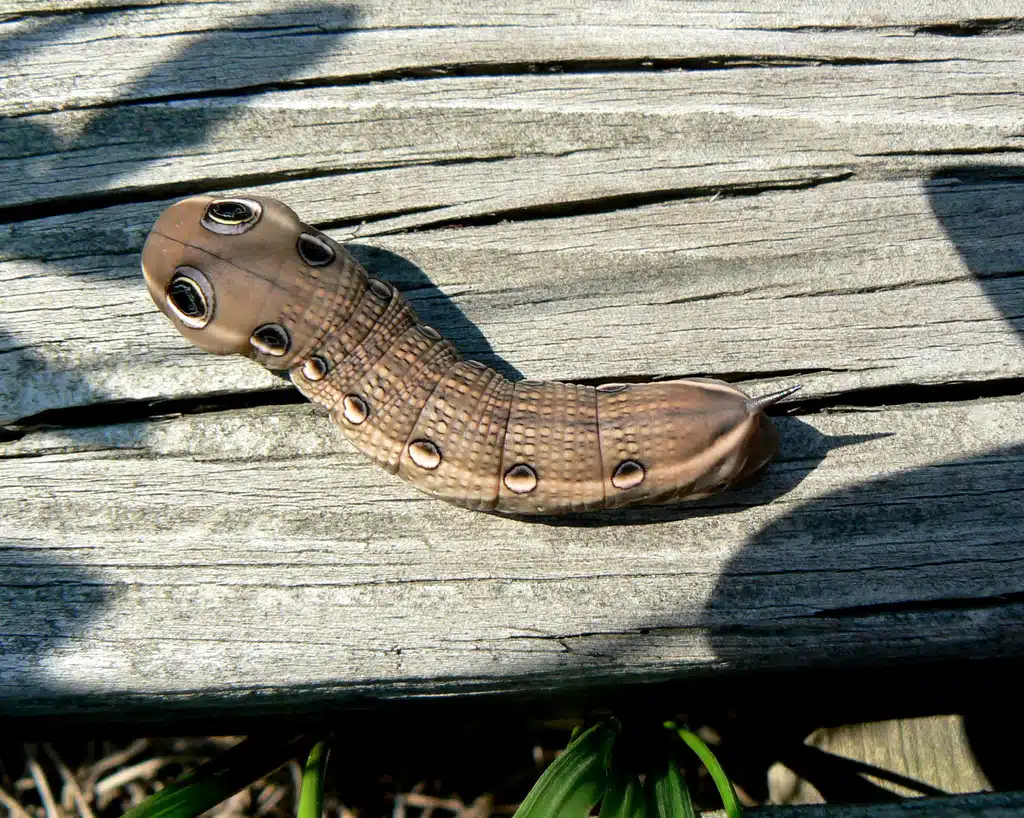
This species (Xylophanes tersa) is seen from March onwards in multiple broods per year.
It has a rare status in South Carolina as opposed to Florida where the species is highly active from February.
This is a type of caterpillar seen on plants such as Smooth buttonplants.
It has a dark brown body with gray and cream or tan sections on the sides.
Tersa Sphinx Caterpillars are also one of the rare species of the state with rows of eyespots along their body.
These aim to confuse predators and make the caterpillar look like a different species.
30. Yellow-striped Armyworm
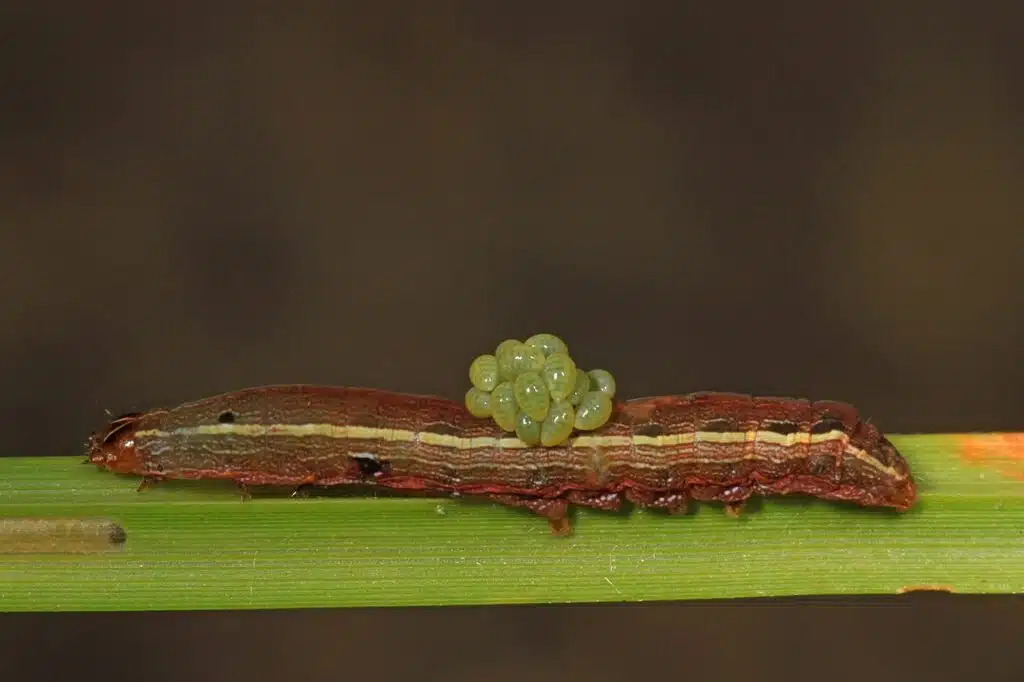
Yellow-striped Armyworm Caterpillars (Spodoptera ornithogalli) get their name from the long yellow stripes along the sides of their dorsum.
This is a pest status that needs management, mainly by insecticides. Crops and alfalfa are impacted by this caterpillar.
Identification is based on its black body with yellow and brown contrasting stripes.
These caterpillars eventually turn to bright yellow or light brown moths with white underwings.
31. Zebra Longwing Caterpillar
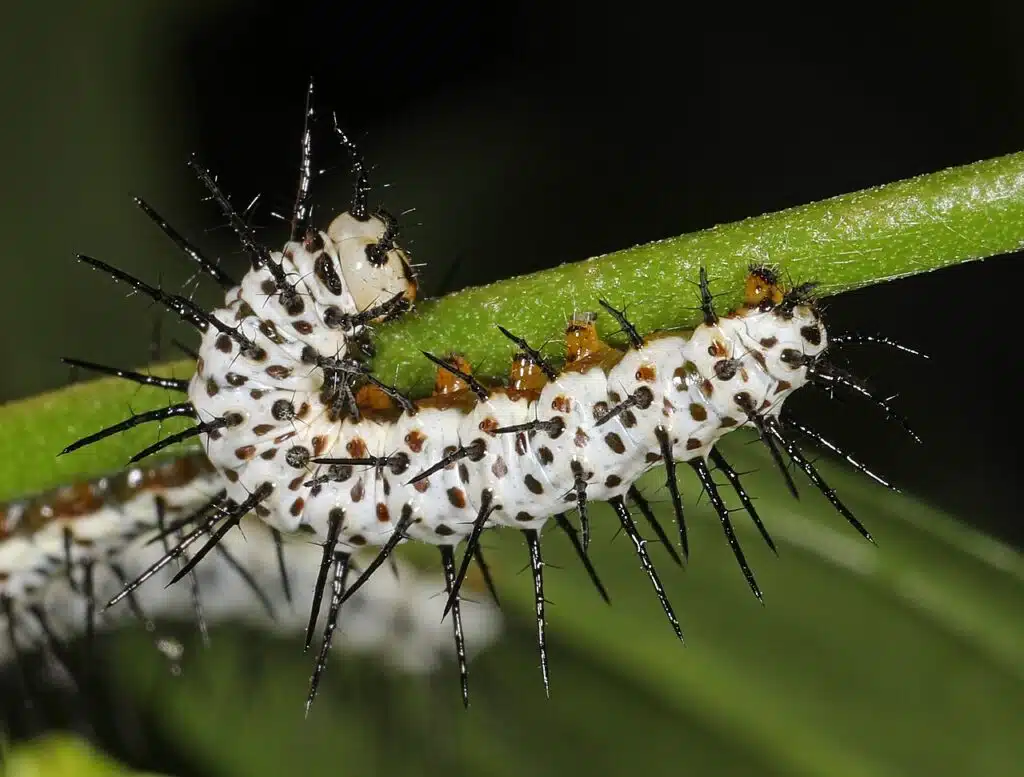
Zebra Longwing Caterpillars (Heliconius charithonia) are large migratory butterflies sometimes spotted in South Carolina.
This is a species known for contrasting colors both as a butterfly and as a caterpillar.
White is the main color of the caterpillar. Red dots contrast its body together with long black spines.
This species is currently seeing a reduction in its numbers in the Southeast, mainly through the application of insecticide in vast areas.
32. Tulip-tree Beauty Caterpillar
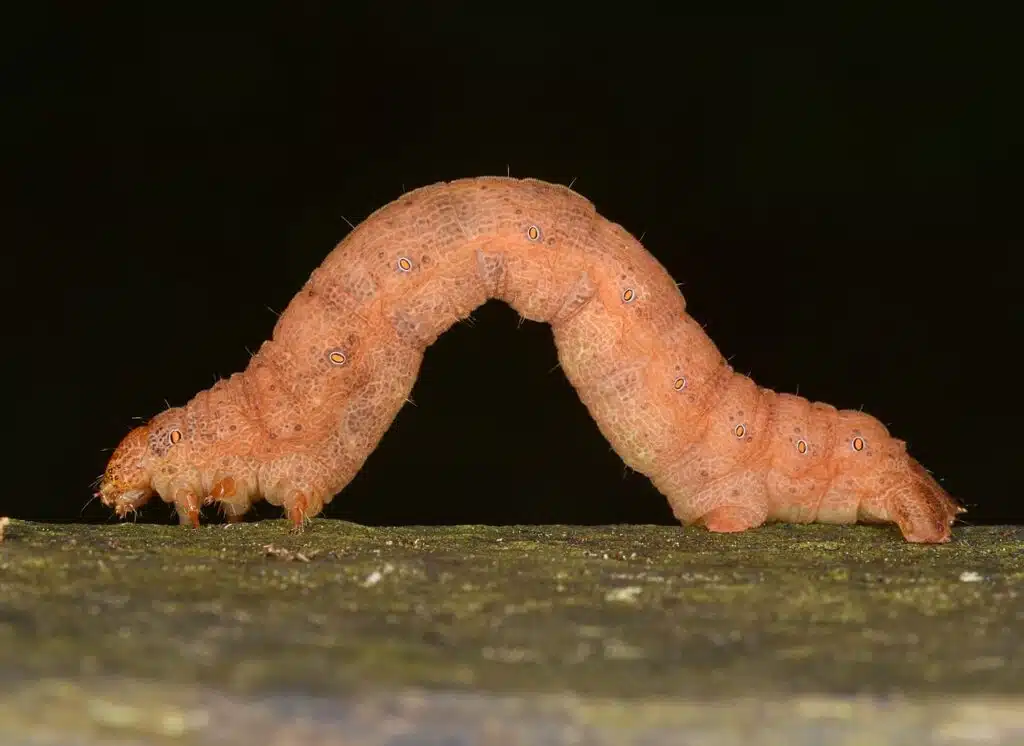
Green and brown colors are specific to the Tulip-tree Beauty Caterpillar (Epimecis hortaria).
Feeding on the leaves of tulip trees, this is a caterpillar that first emerges in green color with a few faded yellow crossbands.
The species eventually turns brown in its later growth stages. These caterpillars are a rare sight in the state.
33. Pink-striped Oakworm
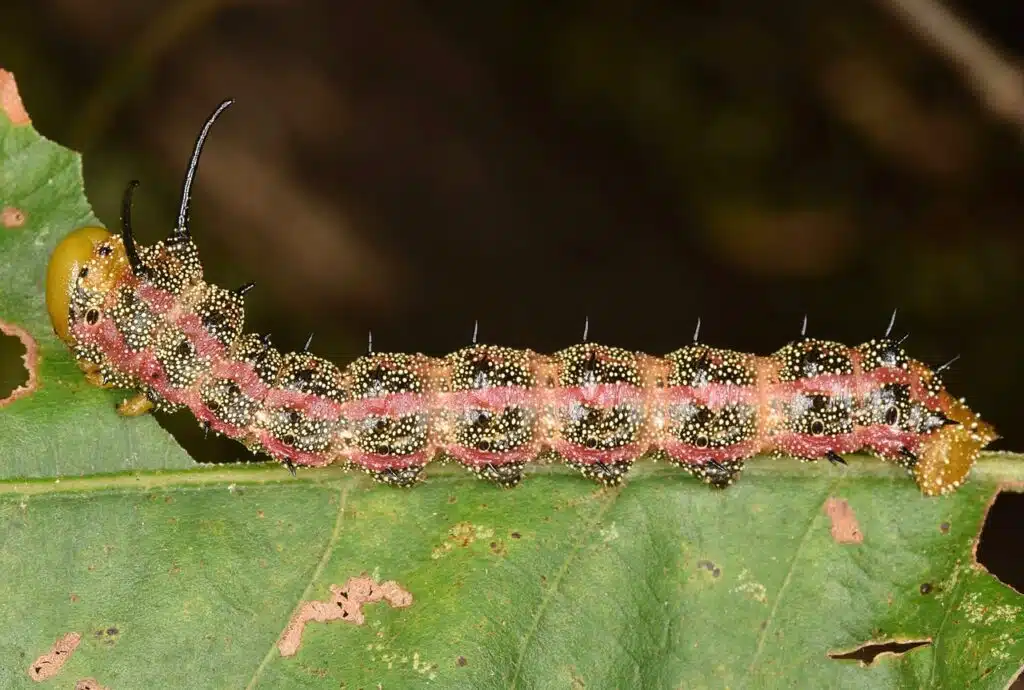
As one of the few pink moths, the Pink-striped Oakworm (Anisota virginiensis) attracts attention in its Eastern and Southeastern US habitat.
Caterpillars of the species have a base black color. Pink stripes appear on the species as it grows.
Tiny contrasting white dots are scattered across its black sections through all of its growth stages.
This caterpillar may be spotted on oak leaves in the summer.
It comes in 2 broods in the state from May onwards with an occasional third brood in some years.
34. Rosy Maple Moth Caterpillar
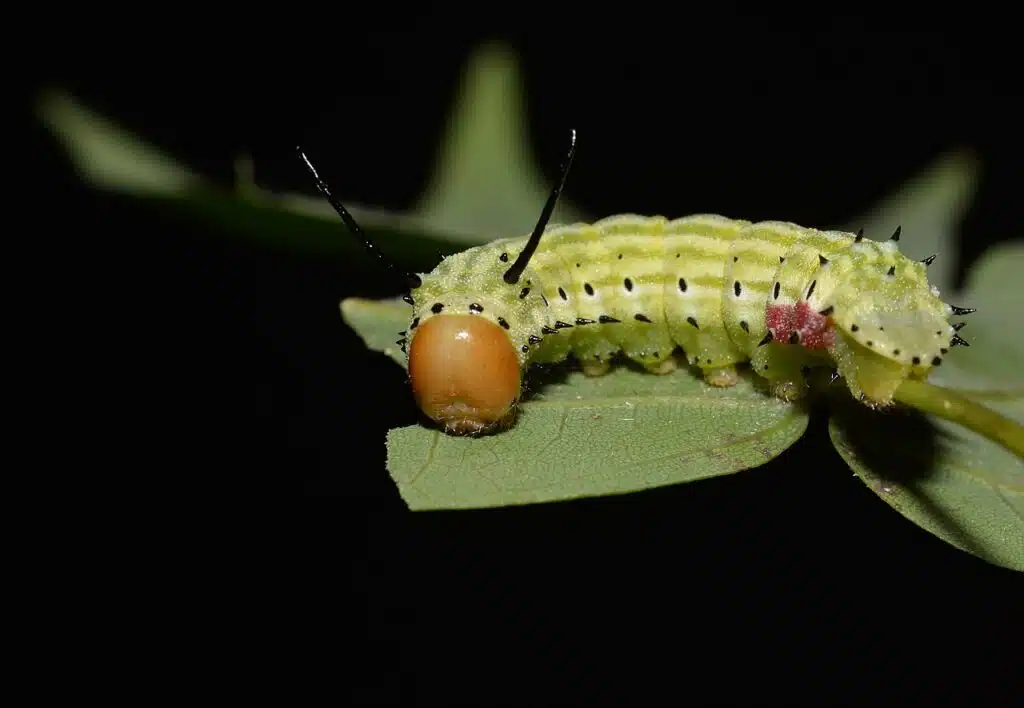
Various species of maple host the Rosy Maple Moth Caterpillar (Dryocampa rubicunda).
This species begins life in groups of eggs laid on the underside of host tree leaves. The emerging caterpillars feed on the leaves of red or silver maple.
The green color is specific to the emerged caterpillar which goes through 5 instars or growth stages.
This caterpillar also shows red and white lateral stripes as it matures.
These lateral stripes also inspired the nickname of Greenstriped Mapleworm of the caterpillar.
Once it emerges, the species maintains pink to red coloring together with large yellow sections.
You can easily spot these caterpillars as they live in groups up to the 3rd instar.
The caterpillars become solitary for the 4th and 5th instar.